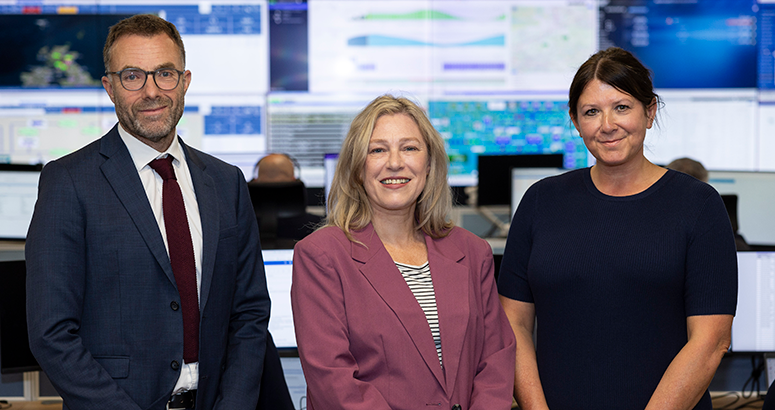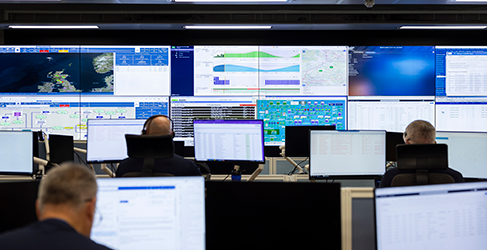Investment in Scotland's Sewers Preventing Pollution
07 August 2024
Massive Investment
Professor Simon Parsons, Director of Environment, Planning and Assurance, and Sharon Hamilton, Manager of the Intelligent Control Centre, host acting Cabinet Secretary for Net Zero and Energy Gillian Martin, at The Bridge, in Stepps, Glasgow to discuss progress on the commitments made in the Improving Urban Waters Routemap
The installation of smart technology – including monitors and sensors - across Scotland’s underground sewer system is already helping to prevent waste water discharges in the marine environment.“It is very encouraging to see the significant progress Scottish Water is making with the delivery of its Improving Urban Waters Routemap.”
Gillian Martin
Acting Cabinet Secretary for Net Zero and Energy
New intelligent network sensors have enabled steps to be taken which have stopped waste water discharging into rivers and averted pollution incidents.
The massive investment in enhancing the performance of the system, which carries more than 1 billion litres a day of waste water into treatment where it is cleaned and returned safely to the environment, is a major part of Scottish Water’s approach to adapting to the impacts of a changed climate on vital national infrastructure.
Net Zero secretary Gillian Martin visited Scottish Water’s main control centre near Glasgow today to hear how investment is helping to update a system largely built more than 100 years ago.
With over 33,000 miles of sewers, an additional £500 million is being spent on the upgrading work.
Alex Plant, Scottish Water’s Chief Executive, said the progress is already making a difference.
He said: “Our rapidly changing climate is putting ever more pressure on our water and waste water systems. That is why we are putting £500m into our Improving Urban Waters routemap.
“And we are really pleased our investment is progressing well and providing us with levels of information and intelligence about what’s going on in our waste water network that we simply haven’t had before.
“This is already delivering significant benefits in terms of us averting pollution and flooding incidents and we can expect this to increase as our ambitious programme continues.”
The investment has included the installation of 232 intelligent network sensors at four high-priority areas in Inverness, Lossiemouth, Erskine, and East Calder. These Waste Water Intelligent Network sensors (WWINs) consider previous environmental impacts in a specific catchment area. They allow prompt and pre-emptive action to prevent environmental pollution incidents.
Already a total of 26 flooding incidents and nine environmental pollution incidents which would otherwise have impacted the water ecosystem have been averted.
A further 25 choke or blockage interventions were made thanks to the new monitoring, and resolved before any impact on customers or the environment was experienced.
In addition, Scottish Water is making good progress with the installation by the end of 2024 of 1000 new Event Duration Monitors (EDMs) at key locations on the network across the country where sewer overflows are considered more likely due to capacity and weather impacts and has already completed 800 of these installations.

Acting Cab Sec Gillian Martin visits Scottish Water

Nerve centre: Intelligent Control Centre at Scottish Water
Further Investment
In a second phase of investment, 1500 network monitors are being deployed in 12 high-priority areas. These will be installed in late 2024 into early 2025.These help Scottish Water and its environmental regulator (SEPA) understand if the sewer network is operating as expected and enable users of the environment to be better informed about what is happening in their local waterbodies.
Professor Simon Parsons, Scottish Water’s Director of Environment, Planning and Assurance, added: “We have learned so much from the four pilots in the first phase of our intelligent networks, particularly around our people, our processes, and our digital systems, and we will use the findings to scale-up our network coverage in the next phases of the initiative.”
Acting Cabinet Secretary for Net Zero and Energy Gillian Martin said: “Scotland’s waterways are in good condition. 87% of Scotland’s waterbodies are of high or good quality, according to the independent body SEPA which monitors Scotland’s waters.
“However, we are not complacent, seek ongoing improvement, and continue to work closely with SEPA and Scottish Water to monitor and improve water quality.
“It is therefore very encouraging to see the significant progress Scottish Water is making with the delivery of its Improving Urban Waters Routemap. This includes excellent progress on its commitment to install 1000 new storm overflow monitors, and also the installation of smart technology at priority locations that can, crucially, help it to anticipate and intervene before environmental pollution and flooding events occur.
“We are also determined to limit the amount of rainwater entering sewers to reduce overflows and have recently published an analysis of the responses to our public consultation on water, wastewater, and drainage which asked the public for their views on how we achieve this.”








